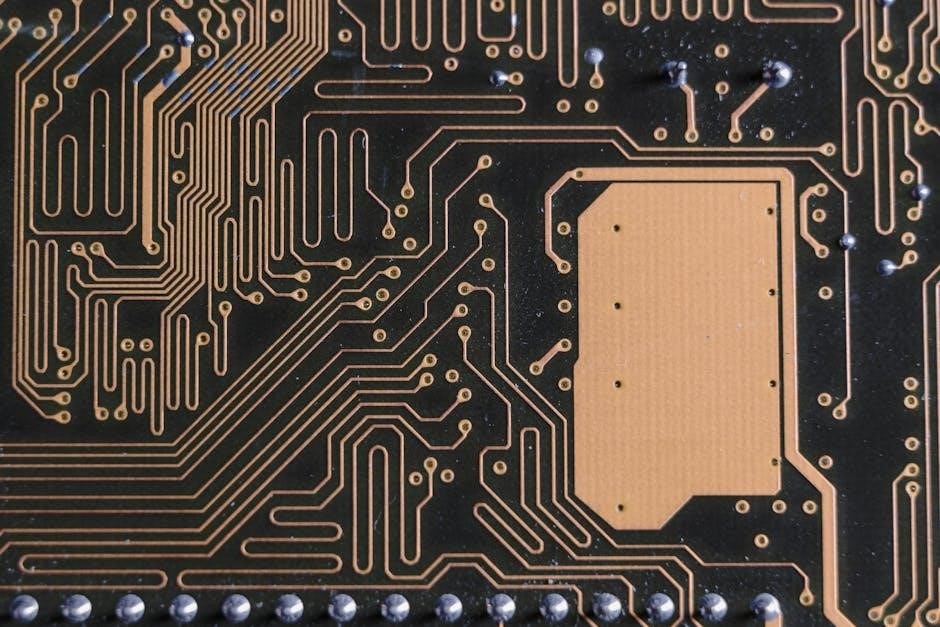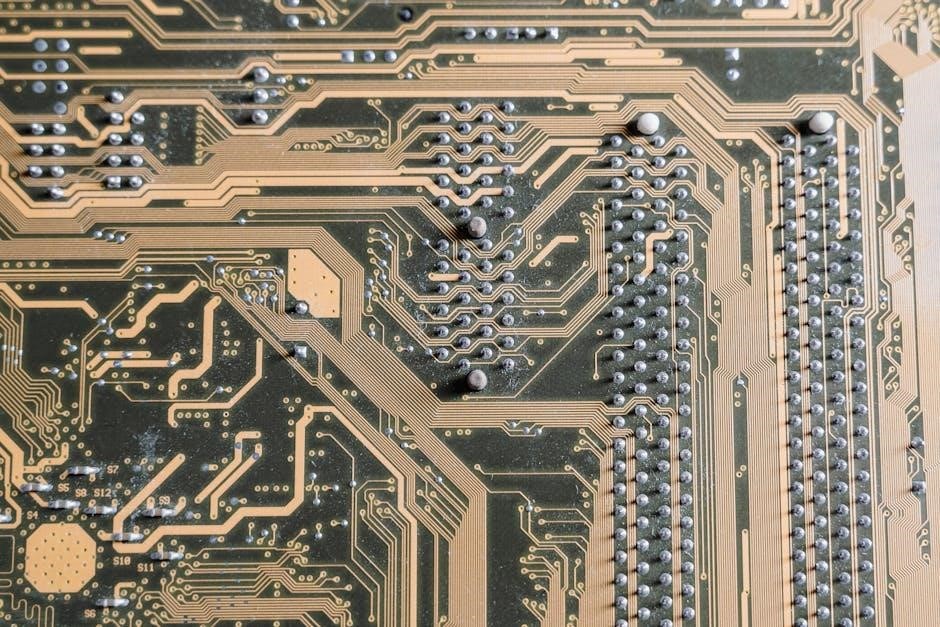The Corrigé Éléments Chimie Secondaire 5 PDF is a comprehensive guide offering corrected exercises and detailed explanations for secondary school chemistry students to master key concepts effectively.

Overview of the Document
The Corrigé Éléments Chimie Secondaire 5 PDF serves as a detailed corrective guide for secondary school chemistry students. It provides a structured approach to understanding key concepts, with corrected exercises and explanations. This document is designed to address common errors and improve problem-solving skills in chemistry. It includes practical examples, step-by-step solutions, and tips for better understanding complex topics. The PDF aligns with the curriculum, ensuring students grasp essential principles through clear and concise corrections. Additionally, it offers self-assessment tools, enabling learners to identify and rectify mistakes independently. This resource is invaluable for reinforcing foundational knowledge and preparing for examinations effectively. By focusing on accuracy and clarity, it supports both students and educators in achieving academic success in chemistry.
Importance of Corrected Chemistry Elements
Corrected chemistry elements are essential for ensuring accuracy and understanding in secondary school chemistry. The PDF provides detailed corrections, helping students identify and rectify mistakes, which is crucial for mastering complex concepts. By addressing errors, it enhances problem-solving skills and reinforces foundational knowledge. Corrected exercises and explanations improve comprehension, enabling students to approach challenging topics with confidence. This resource is particularly valuable for exam preparation, as it highlights common pitfalls and offers clear solutions. Regular use of corrected materials fosters a deeper understanding of chemistry principles, supporting long-term academic success. Additionally, it serves as a reliable tool for educators to assess and improve teaching methods, ensuring high-quality instruction.
Structure of the PDF Document
The Corrigé Éléments Chimie Secondaire 5 PDF is organized into clear sections, each addressing specific aspects of chemistry. It begins with an introduction to corrected chemistry elements, followed by detailed corrections for the periodic table, chemical reactions, and lab safety protocols. The document includes dedicated chapters for common errors, practical exercises, and advanced topics like chemical bonding and thermodynamics. Each section contains sub-sections with examples, solutions, and explanations, ensuring a logical flow of information. The PDF also includes references and further reading materials, making it a self-contained resource for secondary school students. This structured approach helps students navigate complex concepts methodically, reinforcing their understanding and preparation for assessments and future studies.

Understanding the Periodic Table Corrections
The PDF provides detailed corrections to the periodic table, including accurate element symbols, names, and classifications. It helps students understand and apply these corrections effectively in their studies.
Periodic Table Structure and Corrections
The Corrigé Éléments Chimie Secondaire 5 PDF offers a detailed review of the periodic table, highlighting common errors in element classification, symbol usage, and atomic number sequencing. It provides corrected versions of periodic table entries, ensuring accuracy in understanding element properties and their positions. Students can learn how to identify and rectify mistakes in element names, symbols, and groupings. The document also includes explanations for correcting periodic table structure, such as proper placement of metals, non-metals, and metalloids. By addressing these corrections, the guide enhances students’ ability to interpret and apply periodic table data effectively in their chemistry studies. This section is essential for building a strong foundation in chemical element identification and organization.
Symbol and Name Corrections of Elements
The Corrigé Éléments Chimie Secondaire 5 PDF emphasizes the importance of accurate element symbols and names in chemistry. Common errors include incorrect capitalization, such as using “Ag” instead of “ag” for silver, or confusing symbol origins, like “Na” for sodium (from Latin “natrium”). The guide provides corrected symbols and names, ensuring clarity and consistency. For example, “Au” for gold is derived from “aurum,” while “Fe” for iron comes from “ferrum.” Students learn to avoid mixing element names with their symbols, such as writing “gold (Au)” instead of “Gold (AU).” These corrections are vital for precise chemical communication and avoiding misunderstandings in equations and periodic table references. The document also highlights proper formatting, such as using uppercase letters for the first symbol letter and lowercase for the second, if present.
Classification of Elements: Metals, Non-Metals, and Metalloids
The Corrigé Éléments Chimie Secondaire 5 PDF clarifies the classification of elements into metals, non-metals, and metalloids. Metals, such as iron and copper, are typically shiny, malleable, and good conductors of electricity. Non-metals, like oxygen and sulfur, are brittle, poor conductors, and often exist as gases or solids at room temperature. Metalloids, including silicon and boron, exhibit intermediate properties. The guide emphasizes correcting common misconceptions, such as distinguishing between metals and non-metals based on their physical and chemical properties. Proper classification is essential for understanding chemical behavior and reactions. The document also highlights the importance of accurately identifying elements on the periodic table to avoid errors in further studies.

Chemical Reactions and Their Corrections
This section focuses on correcting common errors in chemical reactions, such as balancing equations, identifying reaction types, and addressing stoichiometric inaccuracies for clearer understanding and problem-solving.
Balancing Chemical Equations
Balancing chemical equations is a fundamental skill in chemistry that ensures the number of atoms for each element is equal on both sides of the reaction. This process involves adding coefficients to compounds to achieve balance, starting with the most complex molecules first. Common errors include miscounting atoms or forgetting to balance charges. The PDF provides detailed corrections and step-by-step explanations to address these mistakes, emphasizing the importance of accuracy in representing chemical reactions. By practicing these exercises, students can master the methodology and apply it to more complex reactions in the future.
Types of Chemical Reactions
Chemical reactions are classified into several types, including synthesis, decomposition, single replacement, double replacement, and combustion reactions. Each type has distinct characteristics and examples. The Corrigé Éléments Chimie Secondaire 5 PDF provides corrected exercises and explanations to help students master these reactions. It highlights common errors, such as misidentifying reaction types or miscalculating products. The guide emphasizes the importance of balancing equations and understanding reaction mechanisms. By practicing these exercises, students gain clarity on how substances interact and transform during chemical processes. This section is essential for building a strong foundation in chemistry, enabling students to predict reaction outcomes and apply concepts to real-world scenarios effectively;
Stoichiometry and Mole Calculations
Stoichiometry is the foundation for quantifying chemical reactions, involving mole relationships, molar masses, and limiting reagents. The Corrigé Éléments Chimie Secondaire 5 PDF provides corrected exercises to master these calculations. Common errors include incorrect unit conversions and miscalculations of molar ratios. The guide offers step-by-step solutions, emphasizing precision in determining moles of reactants and products. Practical examples, such as calculating the mass of a substance needed for a reaction, are included to enhance understanding. By addressing frequent mistakes, the PDF helps students build confidence in handling complex stoichiometric problems. This section is vital for applying chemical principles to real-world scenarios, ensuring accurate and efficient problem-solving skills.

Lab Safety and Equipment Handling
Lab safety and proper equipment handling are crucial for preventing accidents. The guide outlines essential safety rules, correct equipment usage, and safe chemical handling procedures to ensure a risk-free environment.
Basic Laboratory Safety Rules
Adhering to basic laboratory safety rules is essential to prevent accidents and ensure a secure environment. Key guidelines include wearing appropriate protective gear such as goggles, gloves, and lab coats. Long hair and loose clothing should be tied back, and jewelry avoided to minimize risks. Students must handle chemicals with care, avoiding direct contact, and never taste or smell substances. Proper ventilation is critical, and experiments should only be conducted under teacher supervision. Familiarity with emergency equipment, such as fire extinguishers and first aid kits, is vital. Following these rules strictly helps create a safe and efficient learning environment for all students engaged in chemistry activities.

Proper Use of Laboratory Equipment
The proper use of laboratory equipment is crucial for accurate experiments and safety. Students should always follow manufacturer guidelines and instructions provided by teachers. Equipment such as microscopes, thermometers, and balances must be handled with care to avoid damage. For instance, measuring instruments like graduated cylinders and pipettes require precise techniques to ensure accurate measurements. Hot objects, such as test tubes or crucibles, should be handled with tongs or heat-resistant gloves to prevent burns. After use, equipment should be cleaned and stored in its designated place to maintain organization and functionality. Proper decontamination and disposal of materials are also essential to prevent contamination and environmental hazards. Regular maintenance of equipment ensures longevity and reliability in future experiments.
Handling Chemical Substances Safely
Handling chemical substances safely is essential to prevent accidents and ensure a secure laboratory environment. Always wear appropriate personal protective equipment (PPE), such as gloves and goggles, when handling chemicals. Read and understand the labels and safety data sheets (SDS) to identify potential hazards. Chemicals should be stored in their original containers in designated areas, away from incompatible substances. Proper ventilation is critical to avoid inhaling harmful fumes. When transferring chemicals, use tongs or spatulas to minimize direct contact. Dispose of waste in labeled containers according to regulations. In case of spills, follow emergency procedures, such as using spill kits or neutralizing agents. Never touch chemicals with bare hands, and wash hands thoroughly after handling substances. Adhering to these practices minimizes risks and promotes a safe learning environment.

Common Errors in Chemistry
Common errors in chemistry include incorrect chemical notations, miscalculations in stoichiometry, and improper unit conversions. These mistakes can lead to incorrect conclusions and experimental failures, emphasizing the need for precision and attention to detail.
Common Mistakes in Chemical Notation
Chemical notation errors are frequent among students, often due to misunderstandings of symbols and formatting. Common mistakes include incorrect use of element symbols, such as confusing capitalization rules or misrepresenting isotopes. For instance, writing “Ag” for silver is correct, but “ag” is not. Another error is improper handling of chemical formulas, like forgetting subscripts or incorrectly placing coefficients. Charges and oxidation states are also often misrepresented, leading to incorrect ionic compound formations. Additionally, students may mix up states of matter in notation, such as omitting (s), (l), or (g) identifiers. These errors highlight the importance of precise notation to avoid confusion and ensure accurate chemical communication.
- Incorrect capitalization of element symbols.
- Misplacement of subscripts and coefficients in formulas.
- Improper representation of charges and oxidation states.
- Omission of state of matter indicators.
Errors in Measuring and Recording Data
Measurement and data recording errors are common in chemistry, often due to improper techniques or carelessness. Calibration errors, such as using uncalibrated instruments, can lead to inaccurate readings. Improper use of measuring tools, like misreading scales or failing to level liquids, is another frequent issue. Rounding errors during data collection can also introduce inaccuracies. When recording data, transcription errors, such as writing numbers incorrectly or omitting units, can occur. Additionally, neglecting significant figures or failing to document observations properly can compromise results. These mistakes emphasize the importance of precision, attention to detail, and proper training in laboratory procedures to ensure reliable and reproducible data.
- Calibration errors leading to inaccurate measurements.
- Improper use of measuring instruments.
- Rounding errors affecting precision.
- Transcription errors during data recording.
Misinterpretation of Chemical Reactions
Misinterpretation of chemical reactions is a common error among students, often leading to incorrect conclusions. One frequent mistake is misidentifying reactants or products, such as confusing symbols or formulas. Another error is failing to balance equations properly, which can alter the reaction’s meaning. Students may also misclassify reaction types, such as confusing synthesis with decomposition reactions. Additionally, misapplying stoichiometric ratios or misunderstanding the role of catalysts can lead to incorrect predictions of reaction outcomes. These errors highlight the importance of careful analysis and attention to detail when interpreting chemical reactions to ensure accurate and valid results.
- Misidentifying reactants or products in chemical equations.
- Incorrect balancing of chemical equations.
- Misclassifying reaction types.
- Misapplying stoichiometric ratios.

Practical Exercises and Solutions
This section provides detailed practical exercises and their solutions, focusing on identifying elements, balancing equations, and calculating molar masses to reinforce key chemistry concepts effectively.
Exercise 1: Identifying Elements and Their Symbols
This exercise focuses on recognizing and matching chemical element symbols with their corresponding names. Students are provided with a list of symbols like Li, O, and Au, and must identify the correct elements (Lithium, Oxygen, Gold). The activity includes multiple-choice questions and fill-in-the-blank tasks to reinforce memory. Additionally, true/false statements, such as “Fe represents Silver,” test understanding of common misconceptions. Detailed corrections highlight proper symbol usage and pronunciation. This foundational exercise ensures students can accurately identify elements, essential for advanced chemistry topics. By mastering this skill, learners build a strong base for understanding periodic table organization and chemical reactions. Correct answers and explanations are provided for self-assessment and improvement.
Exercise 2: Balancing Chemical Equations
This exercise focuses on balancing chemical equations, a fundamental skill in chemistry. Students are provided with unbalanced equations, such as Al + HCl → AlCl₃ + H₂, and guided to balance them step-by-step. The activity emphasizes understanding the law of conservation of mass, ensuring the number of atoms for each element is equal on both sides. Common errors, like forgetting diatomic molecules (e.g., H₂, O₂), are highlighted and corrected. Detailed solutions demonstrate methods like the algebraic approach and trial-and-error. For example, in balancing Ca + H₂O → Ca(OH)₂ + H₂, students learn to properly place coefficients. This exercise reinforces the importance of accuracy in chemical reactions, preparing students for more complex stoichiometry problems. Corrected examples and explanations are included for clarity and self-assessment.
Exercise 3: Calculating Molar Masses
Exercise 3 focuses on calculating molar masses, a crucial skill in chemistry for determining the mass of substances. Students learn to sum atomic masses of elements in a compound using the periodic table. For example, calculating the molar mass of Na₂CO₃ involves adding the atomic masses of sodium (23 g/mol), carbon (12 g/mol), and oxygen (16 g/mol). The exercise emphasizes accuracy and attention to detail to avoid common errors like incorrect multiplication or forgetting diatomic elements. Detailed step-by-step solutions are provided to ensure understanding. This activity prepares students for advanced stoichiometric calculations, reinforcing the importance of precise molar mass determination in chemical reactions and experiments.

Advanced Topics in Chemistry
This section explores complex concepts like chemical bonding, thermodynamics, and electrochemistry, providing corrected examples and detailed explanations to deepen students’ understanding of advanced chemistry principles and applications.
Chemical Bonding and Structure
The section on chemical bonding and structure in the Corrigé Éléments Chimie Secondaire 5 PDF provides detailed corrections and explanations for understanding the formation of chemical bonds. It covers ionic, covalent, and metallic bonding, emphasizing molecular geometry and electron sharing. The corrected exercises clarify common misconceptions, such as distinguishing between polar and nonpolar bonds. Additionally, it explores advanced topics like hybridization and molecular orbitals, ensuring students grasp the foundational principles of chemical structures. The guide includes practical examples with step-by-step corrections, aiding students in mastering the interpretation of Lewis structures and VSEPR theory. This section is essential for developing a strong understanding of how atoms interact and form molecules, supported by clear explanations and corrected exercises for better comprehension and application in advanced chemistry studies.
Thermodynamics and Chemical Changes
The section on thermodynamics and chemical changes in the Corrigé Éléments Chimie Secondaire 5 PDF provides corrected exercises and explanations to help students understand energy transformations in chemical reactions. It focuses on key concepts such as entropy, enthalpy, and Gibbs free energy, with corrected examples to clarify common misunderstandings. The guide also addresses the laws of thermodynamics and their application to chemical systems, ensuring students can interpret and calculate thermodynamic data accurately. Practical exercises include corrections on calorimetry and the determination of reaction spontaneity, while detailed explanations highlight the importance of energy changes in predicting reaction outcomes. This section equips students with the tools to analyze and predict the feasibility of chemical processes, essential for advanced chemistry studies and real-world applications.
Electrochemistry and Its Applications
The section on electrochemistry and its applications in the Corrigé Éléments Chimie Secondaire 5 PDF offers corrected exercises and detailed explanations to help students master the principles of electrochemical cells and their real-world uses. It covers key topics such as redox reactions, electrolysis, and the construction of batteries, with corrected examples to address common errors. The guide also explores electrochemical cells’ thermodynamic basis and their applications in industries like energy storage and metallurgy. Practical exercises include corrections on calculating cell potentials and interpreting electrochemical data. By focusing on both theoretical and practical aspects, this section enables students to understand the importance of electrochemistry in modern technology and sustainability, preparing them for advanced studies and practical problem-solving in the field.
The Corrigé Éléments Chimie Secondaire 5 PDF serves as an essential tool for mastering chemistry through corrected exercises and clear explanations, supporting students in achieving a deeper understanding and exam success.
The Corrigé Éléments Chimie Secondaire 5 PDF provides a detailed review of fundamental chemistry concepts, focusing on the periodic table, chemical reactions, and lab safety. It highlights common errors in chemical notation and data recording, offering corrected examples to enhance understanding. Practical exercises on balancing equations and stoichiometry are included, along with advanced topics like chemical bonding and thermodynamics. The document emphasizes the importance of accurate measurements and proper equipment handling to ensure safe and effective lab practices. By addressing misinterpretations and reinforcing key principles, this guide serves as a valuable resource for secondary students aiming to master chemistry and prepare for further studies.
Importance of Regular Practice
Regular practice is essential for mastering chemistry concepts, as it reinforces understanding and improves problem-solving skills. The Corrigé Éléments Chimie Secondaire 5 PDF emphasizes consistent practice to internalize key principles, such as the periodic table, chemical reactions, and stoichiometry. By regularly engaging with exercises, students can identify and correct common errors, enhancing their accuracy in balancing equations and performing calculations. Practice also builds confidence in lab settings, ensuring safe and proper equipment handling. Over time, regular practice fosters a deeper understanding of chemistry, preparing students for advanced topics and future studies. The corrected exercises in the PDF serve as a valuable tool for reinforcing these practices and achieving academic success.
Future Studies in Chemistry
The Corrigé Éléments Chimie Secondaire 5 PDF serves as a foundational tool for students pursuing advanced chemistry studies. It equips learners with essential skills in chemical notation, reaction analysis, and laboratory practices, which are critical for higher-level courses. The document’s corrected exercises and detailed explanations prepare students for specialized fields such as biochemistry, environmental science, and materials chemistry. By mastering the concepts outlined in the PDF, students gain a strong academic foundation, enabling them to tackle complex topics like electrochemistry and thermodynamics with confidence. Regular use of this resource fosters analytical thinking and problem-solving abilities, which are vital for success in future scientific endeavors. It acts as a bridge between secondary education and university-level chemistry studies, ensuring a smooth transition for aspiring chemists.

References and Further Reading
Key resources include recommended textbooks, scientific journals, and online platforms for chemistry learning. Specific references like Centrale Électrique de l’Ouest Guyanais (CEOG) and Sujet et Corrigé are also highlighted for detailed study.
Recommended Textbooks and Resources
For in-depth learning, several textbooks and resources are highly recommended. Centrale Électrique de l’Ouest Guyanais (CEOG) and Sujet et Corrigé provide detailed exercises and solutions. Additional resources include Chimie Secondaire 5 by leading publishers, offering comprehensive coverage of chemical elements and reactions. Online platforms like Khan Academy and Coursera offer supplementary lessons and practice materials. Scientific journals such as Chemistry Education Research and Practice provide advanced insights. These resources ensure a well-rounded understanding of chemistry concepts, aiding students in mastering both theoretical and practical aspects of the subject. They are essential for reinforcing learning and preparing for further studies.
Online Platforms for Chemistry Learning
Several online platforms offer valuable resources for chemistry learning. Khan Academy provides free video lessons and practice exercises, covering topics like chemical bonding and stoichiometry. Coursera features courses from top universities, such as Harvard and MIT, offering in-depth chemistry content. Additionally, platforms like Brilliant and ChemLibretexts provide interactive exercises and detailed study guides. These resources support students in understanding complex concepts and practicing problem-solving skills. They also include corrected exercises and examples, similar to those found in the Corrigé Éléments Chimie Secondaire 5 PDF, helping students improve their understanding of chemistry effectively. Regular use of these platforms complements traditional learning and enhances academic performance. They are accessible anytime, making learning flexible and convenient for all students.
Scientific Journals and Articles
Scientific journals and articles are essential resources for advanced chemistry learning. Publications like Nature Chemistry and Chemical Reviews provide in-depth research and detailed explanations of chemical concepts. These journals often include corrected exercises and case studies, similar to those in the Corrigé Éléments Chimie Secondaire 5 PDF, to help students understand complex reactions and theories. Online databases like PubMed and ScienceDirect offer access to a wide range of scientific articles, enabling students to explore specific topics in-depth. These resources are particularly useful for educators and students seeking to deepen their knowledge of chemistry through peer-reviewed content. Regular reading of scientific journals enhances critical thinking and prepares learners for future academic and professional challenges in the field. They serve as a bridge between theoretical knowledge and practical applications, fostering a deeper understanding of chemistry.
